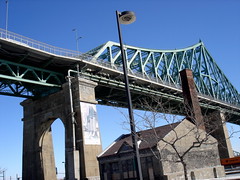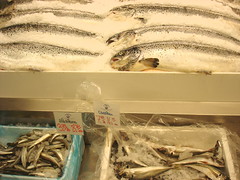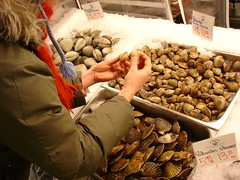Out of the cooler and into the frying pan

Head down towards the Saint Lawrence, almost underneath the Jacques-Cartier Bridge, and you'll find La Mer, Montreal's premier seafood store. No, not in the funny little dilapidated building in the picture above, but close. La Mer's the place where many of the city's high-end restaurants get their seafood. It's not the wondrous wholesale market some of us might have been hoping for--the prices are decidedly retail--but the selection is really without parallel, bringing in more hard-to-find items than any other seafood market we've visited. Ever wonder where restaurants get their Pickle Point and Raspberry Point oysters? Two words: La Mer. And if they're not getting 'em here, they're probably importing their seafood themselves--like they do at Joe Beef and Au Pied de Cochon. Anyway, even though the experience at La Mer isn't exactly like the Fulton Fish Market--no open crates of fresh fish, no crusty old salts, no haggling--the prices actually are reasonable by Montreal standards, and, with its massive walk-in fish cooler/showroom, it's definitely something of an experience. In the summertime they give you a massive coat to keep you warm inside their cooler as you make your selections. In the wintertime make sure you're properly dressed for that bone-chilling Montreal weather--parka, toque, boots, the works--because it's nearly as bone-chilling inside La Mer as it is outside.
We went down to La Mer recently as part of our ongoing survey of Montreal's seafood emporia and, once again, we were impressed by what we saw.
The difference here is not only the selection--it's also the fact that they get more regular shipments than most other seafood stores in town. Other places might only get their delivery once a week--come in three or four days after their last shipment and the displays don't look so hot. This definitely isn't the case at La Mer. Everything always looks incredibly fresh.
We took a couple of tours of the shop, but really we had our hearts set on two things: smoked fish and clams. Smoked fish because we're still in search of Montreal's great, lost smoked fish counter. Clams because we had another hankering for linguine with clam sauce--this time with white clam sauce.
La Mer has a good selection of smoked fish, but it isn't by any stretch of the imagination Montreal's "great, lost smoked fish counter." Apparently they stock smoked sable from time to time--as opposed to most seafood shops in Montreal, we were actually able to find one guy who knew what smoked sable is--but it didn't seem like they stock it all that often. They did have nice smoked salmon and smoked herring, though, so we picked some up. Both, as it turns out, were excellent, but the smoked salmon--from Fumoir Monsieur Émile in Gaspé--is our new favorite, the best we've come across yet in Montreal. It's got a pronounced smokiness to it, but still manages to remain exceedingly delicate.
The selection of clams, on the other hand, was off the hook, as they say. With a number to choose from, we settled on the "pasta clams" from Florida, and Michelle went ahead and tested the little buggers to make sure they were good to go.
When she'd found 20 good ones, we took them and our smoked fish out of the cold room and into the heated room where La Mer's cashiers reside.
Later that night we broke out Bill Buford's Heat: An Amateur's Adventures as Kitchen Slave, Line Cook, Pasta-Maker, and Apprentice to a Dante-quoting Bucher in Tuscany and opened it to the "Line Cook" section, to the part where Buford develops his fascination with the mysteries pasta and polenta, a fascination that eventually takes him to Italy in search of real answers. There, in a passage that comes not long after he's discovered the role of "pasta water" as a secret ingredient in many/all of Mario Batali's pasta dishes (it adds flavor and starchiness, helping to bind the ingredients together), Buford divulges the method for making for making Babbo's linguine with clams as it's actually done in their kitchen:
My advice: ignore the Babbo cookbook and begin by roasting small pinches of garlic and chili flakes and medium pinches of the onion and pancetta in a hot pan with olive oil. Hot oil accelerates the cooking process, and the moment everything gets soft you pour it away (holding back the contents with your tongs) and add a slap of butter and a splash of white wine, which stops the cooking. This is Stage One--and you are left with the familiar messy buttery mush--but already you've added two things you'd never see in Italy: butter (seafood with butter--or any other dairy ingredient--verges on culinary blasphemy) and pancetta, because, according to Mario, pork and shellfish are an eternal combination found in many other places: in Portugal, in amêijoas na cataplana (clams and ham); or in Spain, in a paella (chorizo and scallops); or in the United States, in the Italian-American clams casino, even though none of those places happens to be in Italy. ("Italians," Mario says, "won't fuck with their fish. There are restaurants that won't use lemon because they think it's excessive.")
In Stage Two, you drop the pasta in boiling water and take your messy buttery pan and fill it with a big handful of clams and put it on the highest possible flame. The objective is to cook them fast--they'll start opening after three or four minutes, when you give the pan a swirl, mixing the shellfish juice with the buttery porky white wine emulsion. At six minutes and thirty seconds, you use your tongs to pull your noodles out and drop them into your pan--all that starchy pasta water slopping in with them is still a good thing; give the pan another swirl; flip it; swirl it again to ensure that the pasta is covered by the sauce. If it looks dry, add another splash of pasta water; if too wet, pour some out. You then let the thing cook away for another half minute or so, swirling, swirling, until the sauce streaks across the bottom of the pan, splash it with olive oil and sprinkle it with parsley: dinner.
Our version: vermouth instead of a dry white wine, smoked bacon instead of pancetta, and a little extra cooking time (we have an electric range), but otherwise we followed the instructions above to a tee.
The results: exactly what we were looking for.
La Mer, 1840 René-Lévesque E., 522-3003
aj









3 comments:
Yay! As I was reading this I was thinking "Buford! Buford!" I just finished reading "Heat" last week and I've been looking forward to getting some clams ever since. I loved the part where Mario (was it Mario?) who told him "it's not about the little snot of meat in the clam," that it's about the magical elixir that you get when the hot pasta water mixes with the clam juice and gets soaked into the pasta.
Thanks for the heads-up on La Mer!
AJ,
I was quite excited by this entry. While I've be come quite attached to Coralli, it's a 15 minute drive from my home, while La Mer is but a 5 minute bike ride (in warmer times.) I was, then, quite surprised by what I found. The ambience of the place was much as you described, and certainly the fish was fresh as fresh can be, but it was my sense that the selection was a mere fraction of the selection at Coralli.
Oh, I'll certainly go back there and thanks for calling it to my attention, but if I really want a huge selection and a "Fulton" experience, it's certainly the trek across the "40" I'll make to Coralli's warehouse on Meilleur.
Blork,
Nice to hear from you. Glad to hear you enjoyed Heat as much as we did.
Wayne,
Both Coralli and La Mer are great in their own way. There's no question in my mind that La Mer delivers Coralli a whipping in certain categories (oysters, clams, sashimi-grade fish), and, again, if you want to see where the restaurants get their gear, THAT'S the place. Coralli is phenomenal, though, it's got its own advantages over La Mer, and it's a lot more fun to go to.
Truth be known, Falero is still the place we go to the most. And, ATTENTION, ATTENTION, they, too, have started stocking Monsieur Emile's outstanding smoked salmon. That's right, Falero now stocks M. Emile's smoked salmon.
Bottom line: this isn't a competition, we're just trying to map out the scene.
Post a Comment